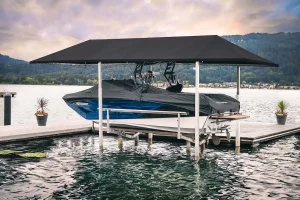Boat lift technology has advanced, transforming boat operations and maintenance. We’ll explore boat lift types and uses, and the impact of technology. Traditional manual lifts have evolved into automated systems, catering to diverse boating needs. Technology simplifies operation and enhances safety. Advancements revolutionize the industry.
Elevated modern boat lift functionalities offer convenience, reduced maintenance, and improved boating experiences. Staying informed about the latest developments is crucial for the boating community.
Key Takeaways
- Boat lifts come in various types, including vertical, floating, cantilever, hydraulic, and air-assisted lifts.
- Technology has greatly enhanced the functionality of modern boat lifts, with features like remote control operation, automated systems, intelligent control systems, advanced sensors, and integration with smart devices.
- Boat lifts are important for protecting boats from water damage, preventing hull damage, facilitating maintenance tasks, and improving vessel performance and longevity.
- When choosing a boat lift, factors to consider include weight capacity, size and dimensions of the boat, type of lift, preferred power source, and additional features like remote control operation and anti-corrosion coatings.
The Importance of Boat Lifts
Boat lifts play a crucial role in the boating industry, frequently ensuring the safe storage and maintenance of watercraft. These specialized structures are designed to lift boats out of the water, providing a secure and convenient solution for boat owners. Boat lifts come in various types and sizes, each catering to different needs and requirements. Some common types include vertical lifts, cantilever lifts, and hydraulic lifts.
The importance of boat lifts cannot be overstated. They not only protect boats from the damaging effects of constant exposure to water, but they also prevent hull damage caused by floating debris and rough water conditions. Additionally, boat lifts make routine maintenance tasks such as cleaning, painting, and repairs much easier. By keeping boats elevated, boat lifts also help prevent the growth of organisms like algae and barnacles, which can negatively impact vessel performance.
Different Types of Boat Lifts
There are several distinct types of boat lifts available in the market today. These lifts are designed to accommodate various types and sizes of boats, providing convenience and protection for boat owners. Here are two sub-lists that explore different types of boat lifts:
- Vertical Boat Lifts
- Vertical boat lifts are the most common type of boat lift. They use a system of pulleys and cables to vertically lift the boat out of the water.
- This type of lift is suitable for boats of different sizes and can accommodate larger vessels with higher weight capacities.
- Floating Boat Lifts
- Floating boat lifts, as the name suggests, use a flotation system to raise the boat out of the water.
- They are ideal for areas with changing water levels or fluctuating tides, as they can adjust accordingly.
These are just a few examples of the boat lifts available in the market. Each type has its own advantages and is designed to meet specific needs. Boat owners should consider their requirements and consult with experts to choose the best boat lift for their needs.
Understanding Boat Lift Uses
Understanding the various applications and purposes of boat lifts is crucial for boat owners looking to maximize the functionality and efficiency of their watercraft. Boat lifts are not just simple devices for storing and protecting boats; they serve a wide range of purposes that cater to the diverse needs of boat owners.
One common use of boat lifts is to facilitate easy and convenient boat launching and retrieval. By raising the boat out of the water, boat owners can avoid the hassle of trailering their boat in and out of the water, saving time and effort.
Additionally, boat lifts can also be used for maintenance and repairs, as they provide a stable and secure platform for working on the boat’s hull and underside.
Moreover, boat lifts can be used for long-term storage, protecting the boat from the damaging effects of the water, such as corrosion and growth of marine organisms.

Advancements in Boat Lift Technology
With the ever-evolving advancements in technology, boat lift functionality has been elevated to new heights. These advancements have revolutionized the way boat owners lift and store their boats, providing more efficient and convenient solutions.
Here are some of the key advancements in boat lift technology:
- Remote Control Operation:
- Boat lifts can now be operated remotely, allowing users to easily raise or lower their boats with the touch of a button. This feature eliminates the need for manual labor and makes the process more convenient and user-friendly.
- Automated Systems:
- Some boat lifts are equipped with automated systems that can detect water levels and adjust the lift accordingly. This ensures that the boat remains at the optimal height, preventing any damage caused by fluctuating water levels.
These advancements not only enhance the functionality of boat lifts but also provide boat owners with a sense of belonging to a community that embraces technological innovations.
How Tech Enhances Modern Boat Lift Functionality
The integration of technology has significantly improved the functionality of modern boat lifts, offering boat owners enhanced convenience and efficiency. Technological advancements have revolutionized the way boat lifts operate, providing a range of features that optimize performance and user experience.
One key technological enhancement is the use of remote control systems. Boat lift owners can now easily operate their lifts with the touch of a button, eliminating the need for manual labor and streamlining the lifting process. These remote control systems also allow for precise positioning, ensuring that the boat is lifted and lowered smoothly and safely.
Additionally, modern boat lifts are equipped with advanced sensors and safety mechanisms. These sensors can detect water levels, preventing the boat from being lifted or lowered if conditions are unsafe. The safety mechanisms also include automatic shut-off features, ensuring that the lift stops operating if any abnormalities or malfunctions are detected.
Furthermore, technology has enabled the development of intelligent control systems that can be integrated with smartphones and other smart devices. Boat owners can now monitor and control their lifts remotely, even when they are not physically present. This level of connectivity and accessibility provides a sense of peace of mind and allows boat owners to manage their lifts efficiently.
Choosing the Right Boat Lift for Your Needs
Boat lift selection plays a crucial role in optimizing the functionality and performance of your modern boat lift system. When choosing the right boat lift for your needs, consider the following:
- Weight capacity: Ensure the boat lift can handle the weight of your vessel without straining the lifting mechanism.
- Size and dimensions: Take into account the length, width, and draft of your boat to ensure a proper fit on the lift.
- Type of lift: There are various types of boat lifts available, such as vertical lifts, hydraulic lifts, and floating lifts. Each type has its own advantages and considerations.
- Power source: Determine whether you prefer an electric or hydraulic-powered boat lift, considering factors such as accessibility and maintenance requirements.
- Additional features: Consider features like remote control operation, adjustable bunks, and anti-corrosion coatings to enhance convenience and durability.
Frequently Asked Questions
How Do Boat Lifts Work?
Boat lifts work by utilizing mechanical or hydraulic systems to raise and lower boats in and out of the water. These systems provide a safe and efficient method for boat storage, maintenance, and launching.
What Are the Benefits of Using a Boat Lift?
Using a boat lift offers numerous benefits, including easy access to your boat, protection from water damage, and reduced maintenance costs. With advanced technology, modern boat lifts provide enhanced functionality and efficiency, making them a valuable asset for boat owners.
Are There Any Safety Considerations When Using a Boat Lift?
Safety considerations are crucial when using a boat lift. Factors such as weight capacity, proper installation, and regular maintenance are essential to ensure safe operation. Additionally, following manufacturer guidelines and using safety features like automatic shut-off systems are recommended.
Can a Boat Lift Be Customized to Fit Different Types and Sizes of Boats?
Yes, boat lifts can be customized to fit different types and sizes of boats. With advancements in technology, modern boat lifts offer adjustable features and customizable options to accommodate various boat dimensions and specifications.
Are There Any Maintenance Requirements for Boat Lifts?
Yes, there are maintenance requirements for boat lifts. Regular inspections and lubrication of moving parts are necessary to ensure proper functioning. Additionally, cleaning and removing debris from the lift system helps prolong its lifespan and prevent damage.
Conclusion
In conclusion, boat lift technology has significantly evolved in recent years, leading to enhanced functionality and efficiency. The integration of technology has simplified operation, improved safety features, and reduced maintenance requirements.
Boat owners now have a wide range of options, from conventional manual lifts to advanced automated systems, to cater to their specific needs. These advancements have revolutionized the boating industry, offering increased convenience and improved overall boating experiences.
Staying informed about the latest developments in boat lift systems is crucial for boat owners to make informed decisions and benefit from these elevated modern functionalities.
You May Also Like:



